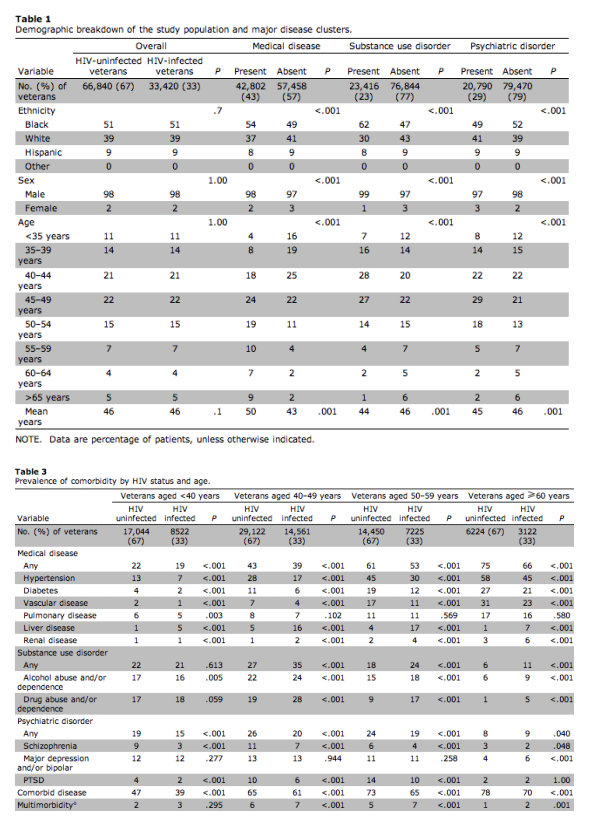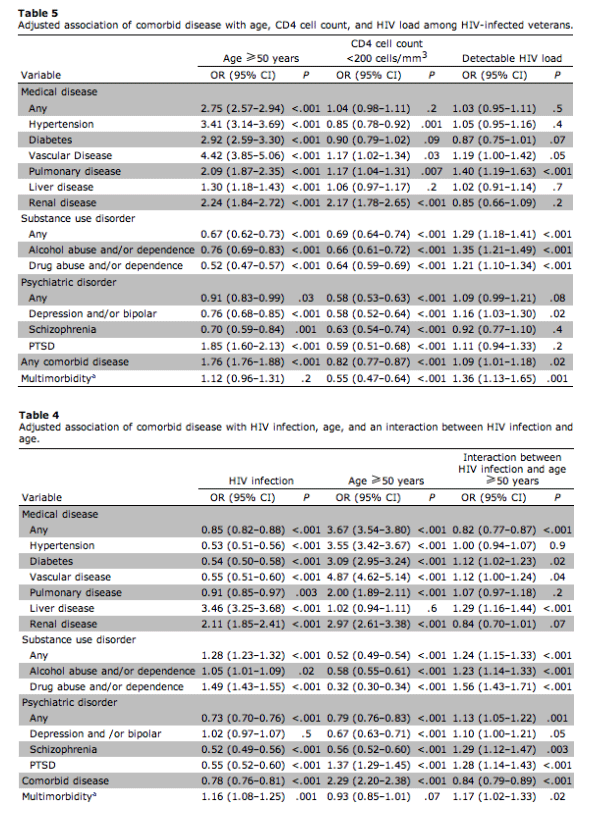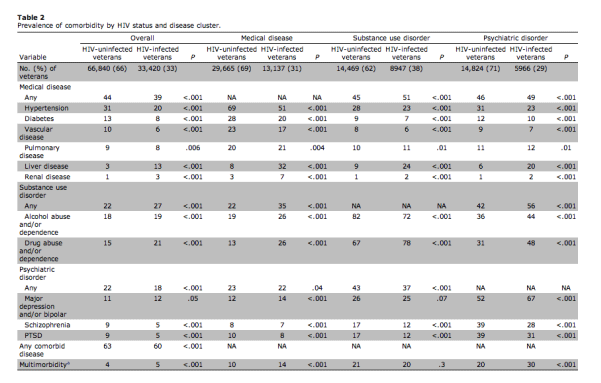| |
Aging with HIV Increases Risk for Comorbidities: Do Patterns of Comorbidity Vary by HIV Status, Age, and HIV Severity?
|
| |
| |
CID Dec 2007
From Jules: the issue of neurologic complications associated with aging is not addressed in this study because this study group nor others are performing neurologic evaluations to assess and understand this problem. I'm not convinced HIV researchers have given much thought to this problem and thus don't understand the concerns and risks. The risks include higher risks compared to the general population for Alzheimer's, Parkinsons, cognitive impairment, muscle degeneration, and demetia.
"Age is known to have a substantial impact on mortality associated with HIV infection [26]. Our work has demonstrated that age also has a major influence on the pattern of comorbid conditions observed....Age was positively associated with all medical comorbidities, except liver disease (p<.001).....Age was associated with increased odds of medical comorbidities, both individually and as a cluster (p<.001 ). Furthermore, there was a statistically significant positive interaction between HIV status and age for diabetes (OR, 1.12; 95% CI, 1.02-1.23), vascular disease (OR, 1.12; 95% CI, 1.00-1.24), and liver disease (OR, 1.29; 95% CI, 1.16-1.44)......Taken together, our data demonstrate that aging veterans with HIV infection experience a substantial burden of comorbid disease and that the pattern of disease differs from the pattern experienced by HIV-uninfected veterans......In multivariable analyses, HIV-infected veterans had a lower risk of hypertension, diabetes, vascular disease, and psychiatric disorders. They had a higher risk of liver disease, renal disease, substance use disorder, and multimorbidity. Older HIV-infected veterans had higher odds of multimorbidity than did older HIV-uninfected veterans. Renal, vascular, and pulmonary diseases were associated with more-advanced HIV infection. Hypertension was associated with CD4 cell count >200 cells/mm3......we did not consider HIV infection as a comorbid condition. If we had, the HIV-infected veterans would have inherently had more medical conditions, because they had HIV infection. As a result, our analyses were biased in favor of finding less comorbidities among veterans with HIV infection.....HIV disease severity and medical comorbidity are positively associated, with 1 exception-hypertension is associated with higher CD4 cell count (OR, 0.85; 95% CI, 0.78-0.92) (table 5). Vascular (OR, 1.7; 95% CI, 1.02-1.34), pulmonary (OR, 1.17; 95% CI, 1.04-1.31), and renal diseases (OR, 2.17; 95% CI, 1.78-2.65) were associated with low CD4 cell count. Vascular (OR, 1.19; 95% CI, 1.00-1.42) and pulmonary diseases (OR, 1.40; 95% CI, 1.19-1.63) were also associated with detectable viral load."



AGING AND INFECTIOUS DISEASES INVITED ARTICLE
Do Patterns of Comorbidity Vary by HIV Status, Age, and HIV Severity?
Clinical Infectious Diseases Dec 17 2007;45:1593-1601
Joseph L. Goulet,1,2 Shawn L. Fultz,3 David Rimland,5 Adeel Butt,6 Cynthia Gibert,4 Maria Rodriguez-Barradas,7 Kendall Bryant,8 and Amy C. Justice1,2
1Veterans Affairs Connecticut Healthcare System, West Haven, and 2Department of Internal Medicine, Yale University School of Medicine, New Haven, Connecticut; 3Veterans Health Administration and 4Veterans Affairs Medical Center and George Washington University Medical Center, Washington, DC; 5Veterans Affairs Medical Center and Emory University School of Medicine, Atlanta, Georgia; 6Veterans Affairs Pittsburgh Healthcare System and University of Pittsburgh, Pittsburgh, Pennsylvania; 7Michael E. De Bakey Veterans Affairs Medical Center and Baylor College of Medicine, Houston, Texas; and 8National Institute on Alcohol Abuse and Alcoholism, National Institutes of Health, Bethesda, Maryland
ABSTRACT.
Patterns of comorbidity among persons with human immunodeficiency virus (HIV) are not well described. We compared comorbidity among veterans with and without HIV infection. The sample consisted of 33,420 HIV-infected veterans and 66,840 HIV-uninfected veterans. We identified and clustered 11 comorbid conditions using validated International Classification of Diseases, 9th Revision, Clinical Modification codes. We defined multimorbidity as the presence of conditions in all clusters. Models restricted to HIV-infected veterans were adjusted for CD4 cell count and viral load. Comorbidity was common (prevalence, 60%-63%), and prevalence varied by HIV status. Differences remained when the veterans were stratified by age. In multivariable analyses, older HIV-infected veterans were more likely to have substance use disorder and multimorbidity. Renal, vascular, and pulmonary diseases were associated with CD4 cell count <200 cells/mm3; hypertension was associated with CD4 cell count >200 cells/mm3. Comorbidity is the rule, and multimorbidity is common among veterans with HIV infection. Patterns of comorbidity differ substantially by HIV status, age, and HIV severity. Primary care guidelines require adaptation for persons with HIV infection.
INTRODUCTION
HIV infection is a complex chronic disease. Regardless of age, persons with HIV infection experience comorbidity associated with race, ethnicity, and socioeconomic status [1-9]. Now that HIV-infected persons are living longer, they also experience long-term toxicity due to treatment and age-associated comorbidity [10]. Furthermore, some comorbid conditions may be caused or exacerbated by HIV disease progression.
It will likely take years to untangle the extent to which non-AIDS-defining conditions, such as diabetes, vascular disease, and liver disease, are independent comorbid conditions or associates of HIV infection and treatment [2-5, 11-13]. The first step in addressing this question is to compare patterns of comorbidity in a sample of HIV-infected individuals with patterns of comorbidity in HIV-uninfected individuals who are similar to those with HIV infection [4]. Because age, race, ethnicity, sex, and economic resources are established factors in determining the prevalence of comorbidity, the HIV-uninfected comparison group must be demographically similar to the HIV-infected group.
Several other factors may be important. We have previously revealed that comorbidity associated with HIV infection tends to cluster into the 3 following categories: medical disease, substance use disorders, and psychiatric disorders [3]. It may also be helpful to know the degree to which comorbidity is associated with markers of HIV disease severity (CD4 cell count and HIV-1 load).
Limitations in prior publications considering patterns of comorbidity associated with HIV infection include small sample size, lack of a demographically similar HIV-uninfected comparison sample, and limited representation of people of color and older individuals [8, 14, 15]. The Veterans Aging Cohort Study (VACS) virtual cohort (n=100,260) includes a 2:1 age-, sex-, and race-matched comparison sample of veterans receiving care during the same year as the index HIV-infected veterans [16]. People of color constitute over one-half of the sample, and nearly one-third of the sample is >50 years of age [16]. We used the VACS virtual cohort to determine how patterns of comorbidity vary by HIV status, comorbidity cluster, age, and markers of HIV severity (CD4 cell count and HIV-1 load).
Results
The VACS virtual cohort consisted of 33,420 HIV-infected veterans receiving care from VA fiscal years 1997 through 2004. These veterans were matched to 66,840 HIV-uninfected veterans.
Demographic matching was successful; there were no significant differences in race, sex, or age by HIV status (p>.2) (table 1). Overall, 60% of the study population were people of color (51% were black, and 9% were Hispanic), 98% were male, and the median age was 45 years. Thirty-one percent were >50 years of age. Veterans with medical comorbidity were more likely to be black (54%) and older (median age, 49 years). Veterans with substance use disorders were more likely to be black (62%) and somewhat younger (median age, 44 years). Veterans with psychiatric disorders were more likely to be white and somewhat older (median age, 46 years).
Stratified results.
The majority of HIV-uninfected and HIV-infected veterans had at least 1 comorbid condition (63% and 60%, respectively; p < .001) (table 2). In both groups, medical comorbidity was the most common problem, and it was more common among HIV-uninfected veterans than among HIV-infected veterans (44% vs. 39%, p < .001). Medical conditions that varied by HIV status included hypertension (31% among HIV-uninfected veterans vs. 20% among HIV-infected veterans; p < .001), diabetes (13% vs. 8%; p < .001), vascular disease (10% vs. 6%; p < .001), liver disease (3% vs. 13%; p < .001), and renal disease (1% vs. 3%; p < .001). Substance use and psychiatric disorder also varied between HIV-uninfected and HIV-infected veterans. Substance use disorders were more common among HIV-infected veterans than among HIV-uninfected veterans (27% vs. 22%; p < .001). Psychiatric disorders were more common among HIV-uninfected veterans than among HIV-infected veterans (22% vs. 18%; p < .001).
When the study population was stratified by disease cluster and HIV status, differences in comorbidity by HIV status remained (table 2). Among HIV-uninfected and HIV-infected veterans with a medical comorbidity, hypertension, diabetes, vascular disease, alcohol abuse and dependence, and posttraumatic stress disorder were more common among HIV-uninfected veterans than among HIV-infected veterans (p < .001). Liver disease (32% vs. 8%; p < .001), renal disease (7% vs. 3%; p < .001), drug abuse and dependence (26% vs. 13%; p < .001), major depression (14% vs. 12%; p < .001), and multimorbidity (14% vs. 10%; p < .001) were more common among HIV-infected veterans than among HIV-uninfected veterans.
Among both HIV-uninfected and HIV-infected veterans with substance use disorders, alcohol abuse and dependence (82% and 72%, respectively; p < .001) (table 2) and drug abuse and dependence (67% and 78%, respectively; p < .001) were common and frequently co-occurred (51% and 50%, respectively; p < .001) (data not otherwise shown). Among veterans with substance use disorders, medical disease was more common among veterans with HIV infection (51% vs. 45%; p < .001), psychiatric disorders were more common among HIV-uninfected veterans (43% vs. 37%; p < .001), and multimorbidity was common in both groups (20% among HIV-infected veterans and 21% among HIV-uninfected veterans; p < .001).
Among HIV-uninfected and HIV-infected veterans with psychiatric disorders, major depression or bipolar disease was more common among HIV-infected veterans than among HIV-uninfected veterans (67% vs. 52%; ) (table 2). Schizophrenia (39% vs. 28%; ) and posttraumatic stress disorder (39% vs. 31%; p < .001) were more common among HIV-uninfected veterans than among HIV-infected veterans. Both medical disease (49% vs. 46%; ) and substance use disorders (56% vs. 42%; p < .001) were more common among veterans with HIV infection. Among those with a psychiatric disorder, multimorbidity was more common among HIV-infected veterans than among HIV-uninfected veterans (30% vs. 20%; p < .001).
When disease prevalence was considered by HIV status and age, differences by HIV status remained (p < .001, for most conditions and clusters in most age categories) (table 3). For conditions that tended to decrease in prevalence with age (i.e., substance use disorders, psychiatric disorders, and liver disease), veterans with HIV infection experienced a less pronounced decrease than did HIV-infected veterans. For conditions that tended to increase in prevalence with age (i.e., hypertension, diabetes, vascular disease, pulmonary disease, and renal disease), veterans with HIV infection experienced a more pronounced increase than did HIV-uninfected veterans. The proportion of HIV-uninfected and HIV-infected veterans with any comorbid disease increased with each decade. Nearly three-quarters of those aged 60 years had comorbidity (78% of HIV-uninfected veterans and 70% of HIV-infected veterans; p < .001). Multimorbidity was more common among HIV-infected veterans aged 50 years than among HIV-uninfected veterans aged 50 years (p < .001).
Multivariable results.
In a series of multivariable logistic models of each of the 11 conditions and 3 clusters that were adjusted for race, ethnicity, sex, age, HIV status, and testing for a statistical interaction between HIV status and age, the stratified results were supported and extended (table 4). HIV infection was associated with a lower odds of medical comorbidities, both individually and as a cluster, with the exceptions of liver disease (OR, 3.46; 95% CI, 3.25-3.68) and renal disease (OR, 2.11; 95% CI, 1.85-2.41). Age was associated with increased odds of medical comorbidities, both individually and as a cluster (p < .001). Furthermore, there was a statistically significant positive interaction between HIV status and age for diabetes (OR, 1.12; 95% CI, 1.02-1.23), vascular disease (OR, 1.12; 95% CI, 1.00-1.24), and liver disease (OR, 1.29; 95% CI, 1.16-1.44).
Despite the negative association between the substance use and psychiatric disorder clusters and age, both clusters demonstrated positive interactions between HIV status and older age. Overall, older HIV-infected veterans had higher odds of substance use disorder (OR, 1.28; 95% CI, 1.23-1.32) than did older HIV-uninfected veterans after adjustment for general effects of age, HIV, race, ethnicity, and sex. Similarly, older HIV-infected veterans had higher odds of psychiatric disorders (OR, 1.13; 95% CI, 1.05-1.22). Older veterans with HIV infection also had higher odds of multimorbidity (OR, 1.17; 95% CI, 1.02-1.33). Age was positively associated with all medical comorbidities, except liver disease (p < .001). Age was negatively associated with substance use and psychiatric disorders (p < .001).
HIV disease severity and medical comorbidity are positively associated, with 1 exception-hypertension is associated with higher CD4 cell count (OR, 0.85; 95% CI, 0.78-0.92) (table 5). Vascular (OR, 1.7; 95% CI, 1.02-1.34), pulmonary (OR, 1.17; 95% CI, 1.04-1.31), and renal diseases (OR, 2.17; 95% CI, 1.78-2.65) were associated with low CD4 cell count. Vascular (OR, 1.19; 95% CI, 1.00-1.42) and pulmonary diseases (OR, 1.40; 95% CI, 1.19-1.63) were also associated with detectable viral load.
Low CD4 cell count was associated with a decreased odds of substance use disorders (OR, 0.69; 95% CI, 0.64-0.74) (table 5) and psychiatric disorders (OR, 0.58; 95% CI, 0.53-0.63). Detectable viral load was associated with substance use disorders (OR, 1.29; 95% CI, 1.18-1.41) and depression (OR, 1.16; 95% CI, 1.03-1.30). Detectable viral load was also associated with a greater risk of having a comorbid condition (OR, 1.09; 95% CI, 1.01-1.18) and multimorbidity (OR, 1.36; 95% CI, 1.13-1.65).
Methods
Sample. The VACS virtual cohort is described in detail elsewhere [16]. To construct the VACS virtual cohort, we adapted an algorithm used by Fasciano et al. [17] to identify HIV-infected veterans using Veterans Affairs (VA) electronic medical records from VA fiscal years 1997 through 2004. Our program searched for the following International Classification of Diseases, 9th Revision, Clinical Modification (ICD-9-CM) [18] diagnosis codes in VA administrative records at the Austin Automation Center (Austin, TX): AIDS (042), asymptomatic HIV (V08), and related Diagnostic-Related Group codes (488-490). Both the inpatient and outpatient files were searched. We have demonstrated that this algorithm correctly identifies 100% (sensitivity) of the veterans receiving HIV care. The specificity is 96.1%, the positive predictive value is 97.2%, and the negative predictive value is 100% [16].
ICD-9-CM codes for comorbid conditions were extracted from the files in a similar manner. The ICD-9-CM code groupings used for each comorbid medical condition have been described in detail elsewhere [19] and were built on the work of Deyo et. al. [20], Elixhauser et. al. [21], and the Clinical Classifications Software developed by the Agency for Healthcare Research and Quality. We previously conducted an extensive chart review to determine the accuracy of code groupings among veterans receiving care using data collected as part of the Veterans Aging Cohort 3 Site Study. Among a sample of 876 veterans, the specificity of the codes selected for individual medical conditions (e.g., diabetes) ranged from 92% to 99% [19]. The classification of substance abuse and psychiatric disorders from ICD-9-CM codes was based on the methods of Druss and Rosenheck [22].
To avoid overly complex tables, we considered medical diagnoses by organ system. Vascular disease included myocardial infarction, coronary artery disease, stroke, and peripheral vascular disease. Pulmonary disease included chronic obstructive pulmonary disease, pulmonary hypertension, asthma, bronchiectasis, alveolitis, pneumoconiosis, and interstitial and/or fibrotic lung diseases. Liver disease included end-stage liver disease, decompensated liver disease, and hepatitis B and C viruses. Renal disease included renal insufficiency, renal failure, and glomerulonephritis. We also formed larger clusters, including all medical diseases, substance disorders, and psychiatric disorders on the basis of previous work [3]. This addressed the problem of the covariance among related conditions (e.g., alcohol and drug use). For these analyses, we defined multimorbidity as the presence of a comorbid condition in all 3 clusters.
HIV-uninfected comparison sample. After we identified the HIV-infected veterans, we identified HIV-uninfected veterans for comparison. Each identified HIV-infected index patient was matched to 2 HIV-uninfected control subjects on the basis of the index patient sex, age (5-year intervals), race and ethnicity (black, white, Hispanic [either black or white], and other), and geographic location. Control subjects could not have any HIV-related diagnostic codes. Control subjects were required to have had an inpatient stay or outpatient visit during the same fiscal year and in the same geographic region as the corresponding HIV-infected patient.
The development of our cohort was approved by the institutional review boards of the VA Connecticut Healthcare System and Yale University School of Medicine and was granted a waiver of informed consent. The project was Health Insurance Portability and Accountability Act compliant.
Statistical analyses. We calculated the prevalence of comorbid conditions on the basis of the observed proportion of veterans with that condition among the total sample and stratified by HIV-infection status. The χ2 test was used to assess the association between dichotomous variables, and Student's t test was used to compare differences of continuous variables between the groups. We performed 2 steps to ensure that we only emphasized differences that were both clinically and statistically important. First, we rounded all percentages to whole percentages. Second, we mentioned only those results that were both statistically significant and reflected at least 2% absolute difference (e.g., 38% vs. 36%) or a 2-fold difference in overall proportions (e.g., 1% vs. 2%). Logistic regression was used to calculate age-adjusted (with age >50 years coded 0/1), race-adjusted (with black race coded 0/1), and sex-adjusted ORs for each comorbid condition and cluster comparing HIV-uninfected veterans with HIV-infected veterans. In the overall model, an interaction term was included for HIV infection and age >50 years. We also ran a series of regressions restricted to HIV-infected veterans, including CD4 cell count (with a CD4 cell count <200 cells/mm3 coded 0/1) and detectable viral load (with a viral load >500 copies/mL, coded 0/1). Statistical significance for all tests was defined as a 2-tailed P value <.05. All analyses were performed using SAS, version 9.1 (SAS Institute).
|
|
| |
| |
|
|
|